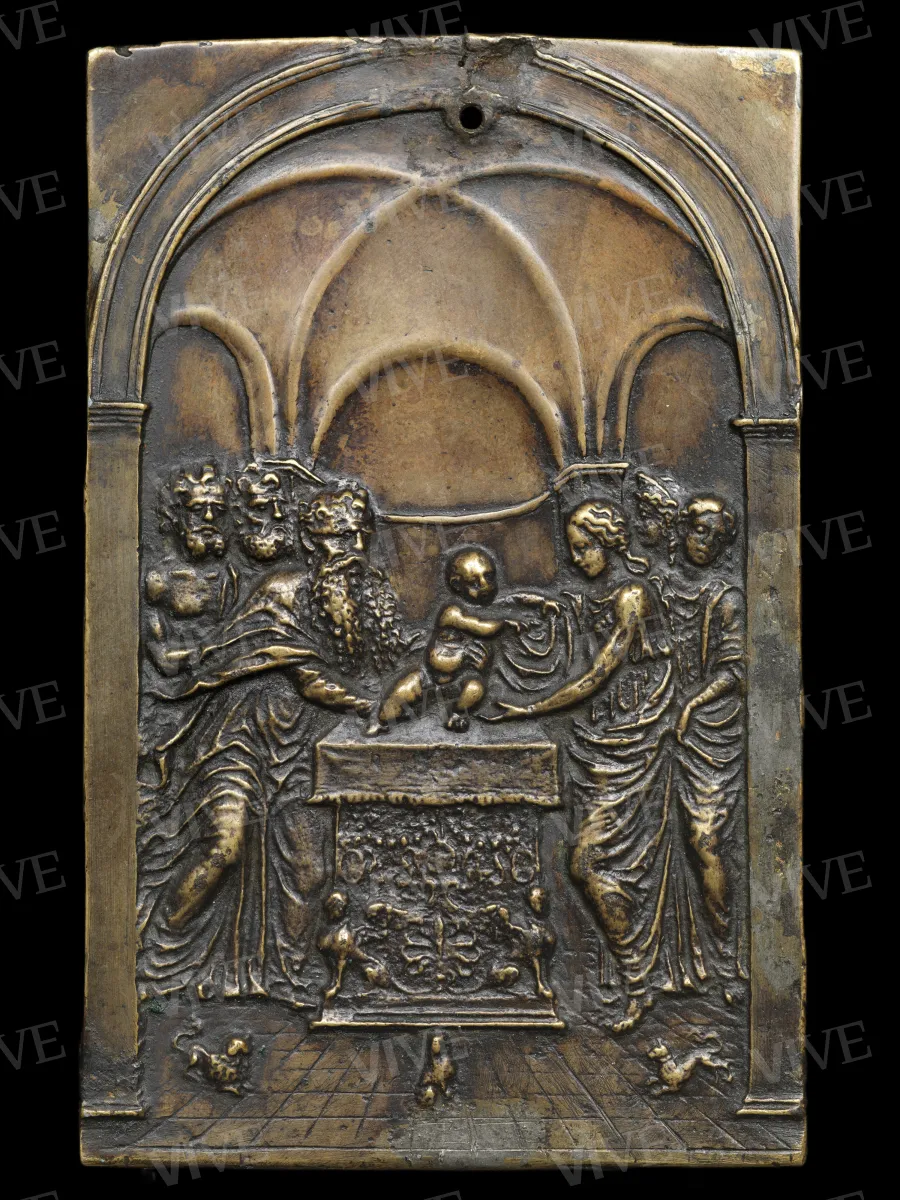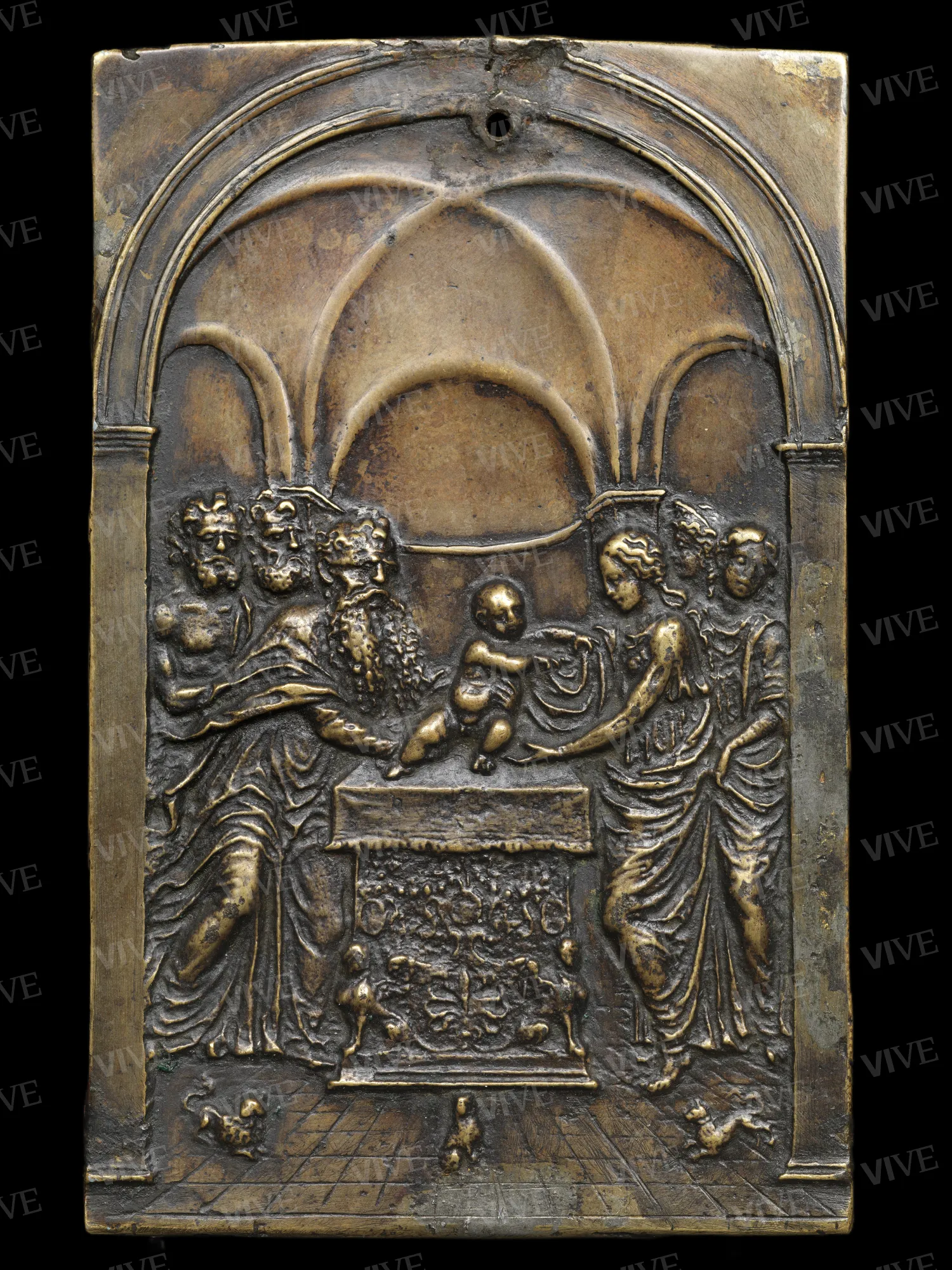Presentation of Jesus at the Temple
Galeazzo Mondella called Il Moderno C. 1490-1495
The Presentation of Jesus at the Temple is the work of the Veronese goldsmith Galeazzo Mondella, known as Il Moderno, and can be dated to the last decade of the fifteenth century. The plaque, perhaps made in Mantua, demonstrates the influence of the artistic stimuli coming from northern Italy, starting with Andrea Mantegna. The airy vaulted architecture evokes the spatial research of the second half of the century and recalls the Venetian altarpieces, such as that of Bartolomeo Montagna for the church of San Bartolomeo in Vicenza.
The Presentation of Jesus at the Temple is the work of the Veronese goldsmith Galeazzo Mondella, known as Il Moderno, and can be dated to the last decade of the fifteenth century. The plaque, perhaps made in Mantua, demonstrates the influence of the artistic stimuli coming from northern Italy, starting with Andrea Mantegna. The airy vaulted architecture evokes the spatial research of the second half of the century and recalls the Venetian altarpieces, such as that of Bartolomeo Montagna for the church of San Bartolomeo in Vicenza.
Details of work
Catalog entry
The Presentation of Jesus at the Temple depicts Mary and Joseph bringing the infant Jesus to the temple in Jerusalem for presentation to the priest Simeon, as described in the Gospel of Luke. The setting is within a structured architectural space featuring a ribbed vault supported by arches and pillars, with depth defined by an apsidal basin. Besides the three main figures (Simeon, Jesus, Mary), there are two pairs of characters in the background: two men behind Simeon and two women behind the Virgin. The iconography of the subject follows the tradition established by Giotto in the Scrovegni Chapel in Padua, with the Child being given into the arms of the priest while attempting to return to his mother, clinging to her arm. The altar is decorated in the ancient style with sphinxes, palmettes, and medallions (as described by Lewis in 1989), while three small dogs are present on the floor. The Presentation is part of a series of plaques by the artist dedicated to the life of Christ, including the Adoration of the Magi, the Flagellation, the Crucifixion, and the Resurrection. These examples are housed in the Museo di Palazzo Venezia from the Viennese collection of the ambassador Giacinto Auriti (Santangelo 1964; Cannata 1982). Initially, critics such as Middeldorf and Goetz (1944) interpreted this Christological series in relation to Milan’s artistic culture influenced by Leonardo. However, this suggestion was disregarded since Pope-Hennessy (1965), with the exception of Rossi (2007). Cannata (1982) proposed that the architectural composition and construction were influenced by art from beyond the Alps seen in prints by Galeazzo Mondella, known as il Moderno (1467–1528), without specifying precise references. Lewis (1989) has linked the composition to the artistic culture of the Veneto, specifically to paintings by Antonio Vivarini from the 1450s. He has also noted the relationship between the figures of the Madonna and Child and those in the Circumcision by Andrea Mantegna, originally part of a triptych in Mantua and now in the Uffizi. The architectural space of the plaque appears to be inspired by Venetian altarpieces of the late fifteenth century, similar to the works of Piero della Francesca and Antonello da Messina. In terms of monumental architecture, the plaque is comparable to the altarpiece by Bartolomeo Montagna for the church of San Bartolomeo in Vicenza, now located in the Museo Civico di Palazzo Chiericati in the same city, which features an airy ribbed, vaulted pavilion. The painting dates back to around 1485 and provides a terminus post quem for the bronze plaque, which critics have placed in the last two decades of the fifteenth century.
Historically, symbolic meanings have been attributed to the sphinxes that adorn the altar, intended as an allusion to the eternity of life after death. Additionally, the three dogs have been interpreted as representing Charity, Love, and Friendship or the mockery of Christ (Lewis 1989, p. 136, n. 148). Rossi (2007) hypothesizes that the sphinxes and dogs may allude to the emblems of the Gonzaga family, suggesting that the plaque’s creation in Mantua could have been commissioned by the marquises. This hypothesis merits further investigation. Among numerous examples, notable instances include those in Paris (Molinier 1886), Berlin (Bange 1922), Cleveland (Wixom 1975), London (Pollard 1989), the Bargello in Florence (Toderi, Vannel Toderi 1996), Turin (A.S.F. 1982), Washington (Lewis 1989), and Oxford (Warren 2014). Pope-Hennessy (1965) published a variant of this plaque with worked surfaces to indicate the stone blocks of the walls.
Giulio Pietrobelli
Entry published on 27 March 2025
State of conservation
Good. Natural brown patina, traces of dark lacquer.
Provenance
Vienna, Collezione Giacinto Auriti, assembled between 1922 and 1933, no. 5;
Rome, Museo Nazionale di Palazzo Venezia, donated in 1963.
References
Molinier Émile, Les bronzes italiens de la Renaissance. Les plaquettes. Catalogue raisonné, Paris 1886, I, pp. 126, 128, n. 169;
Bange Ernst Friedrich (a cura di), Die Italienischen Brozen der Renaissance und des Barock: Riliefs und Plaketten, Berlin 1922, II, p. 62, n. 452, tav. 48;
Maclagan Eric, Victoria & Albert Museum. Catalogue of Italian Plaquettes, London 1924, p. 29, n. 4081-1857, tav. 8;
De Ricci Seymour, The Gustave Dreyfus Collection. Reliefs and Plaquettes, Oxford 1931, pp. 129-130, nn. 167-168;
Imbert Eugenio, Morazzoni Giuseppe (a cura di), Le placchette italiane. Secolo XV-XIX. Contributo alla conoscenza della placchetta italiana, Milano 1941, n. 106, tav. 20;
Middeldorf Ulrich, Goetz Oswald, Medals and Plaquettes from the Sigmund Morgenroth Collection, Chicago 1944, p. 33, n. 229;
Cott Perry, Renaissance Bronzes: Statuettes, Reliefs and Plaquettes, Medals and Coins from The Kress Collection, Washington 1951, p. 151;
Santangelo Antonino, Museo di Palazzo Venezia. La collezione Auriti. Piccoli bronzi, placchette, incisioni e oggetti d’uso, Roma 1964, pp. 35-36;
Pope-Hennessy John, Renaissance Bronzes from the Samuel Kress H. Collection. Reliefs, Plaquettes, Statuettes, Utensils and Mortars, London 1965, p. 46, nn. 145-146, figg. 174-175;
Wixom William, Renaissance Bronzes from Ohio Collections, The Cleveland Museum of Art, Cleveland 1975, n. 41;
A.S.F., in Dagli ori antichi agli anni Venti. Le collezioni di Riccardo Gualino, catalogo della mostra (Torino, Palazzo Madama, Galleria Sabauda, dicembre 1982-marzo 1983), Milano 1982, p. 122 n. 58;
Cannata Pietro (a cura di), Rilievi e placchette dal XV al XVIII secolo, catalogo della mostra (Roma, Museo di Palazzo Venezia, febbraio-aprile 1982), Roma 1982, pp. 49-50, n. 25;
Lewis Douglas, The Plaquettes of Moderno and His Followers, in «Studies in the History of Art», 22, 1989, pp. 105-141;
Pollard Graham, The Plaquette Collections in the British Museum, in «Studies in the History of Art», 22, 1989, pp. 227-245, n. 185;
Toderi Giuseppe, Vannel Toderi Fiorenza, Placchette. Secoli XV-XVIII nel Museo Nazionale del Bargello, Firenze 1996, pp. 89-90, n. 158;
Rossi, in Di Lorenzo Andrea, Frangi Francesco (a cura di), La raccolta Mario Scaglia. Dipinti e sculture, medaglie e placchette da Pisanello a Ceruti, Cinisello Balsamo, Milano 2007, p. 64, n. 8;
Warren Jeremy (a cura di), Medieval and Renaissance Sculpture. A Catalogue of the Collection in the Ashmolean Museum, Oxford. Volume 3. Plaquettes, Oxford 2014, pp. 844-845, n. 300.












